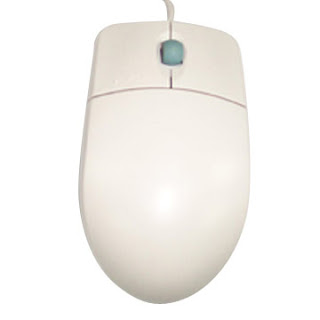 A device that controls the movement of the cursor or pointer on a display screen. A mouse is a small object you can roll along a hard, flat surface. Its name is derived from its shape, which looks a bit like a mouse, its connecting wire that one can imagine to be the mouse's tail, and the fact that one must make it scurry along a surface. As you move the mouse, the pointer on the display screen moves in the same direction. Mice contain at least one button and sometimes as many as three, which have different functions depending on what program is running. Some newer mice also include a scroll wheel for scrolling through long documents.
A device that controls the movement of the cursor or pointer on a display screen. A mouse is a small object you can roll along a hard, flat surface. Its name is derived from its shape, which looks a bit like a mouse, its connecting wire that one can imagine to be the mouse's tail, and the fact that one must make it scurry along a surface. As you move the mouse, the pointer on the display screen moves in the same direction. Mice contain at least one button and sometimes as many as three, which have different functions depending on what program is running. Some newer mice also include a scroll wheel for scrolling through long documents.
Invented by Douglas Engelbart of Stanford Research Center in 1963, and pioneered by Xerox in the 1970s, the mouse is one of the great breakthroughs in computer ergonomics because it frees the user to a large extent from using the keyboard. In particular, the mouse is important for graphical user interfaces because you can simply point to options and objects and click a mouse button. Such applications are often called point-and-click programs. The mouse is also useful for graphics programs that allow you to draw pictures by using the mouse like a pen, pencil, or paintbrush.
|
Work anywhere in the world with 'Treasure Trooper' & get paid. |
Who invented the computer mouse
Who invented the computer

Charles Babbage is most often credited with the invention of the computer...
It is difficult to identify any one device as the earliest computer, partly because the term "computer" has been subject to varying interpretations over time. Originally, the term "computer" referred to a person who performed numerical calculations (a human computer), often with the aid of a mechanical calculating device.
Hero of Alexandria (c. 10–70 AD) built a mechanical theater which performed a play lasting 10 minutes and was operated by a complex system of ropes and drums that might be considered to be a means of deciding which parts of the mechanism performed which actions and when.
The "castle clock", an astronomical clock invented by Al-Jazari in 1206, is considered to be the earliest programmable analog computer.
Wilhelm Schickard's 1623 device was the first of a number of mechanical calculators constructed by European engineers.
In 1801, Joseph Marie Jacquard made an improvement to the textile loom that used a series of punched paper cards as a template to allow his loom to weave intricate patterns automatically.
In 1837, Charles Babbage was the first to conceptualize and design a fully programmable mechanical computer that he called "The Analytical Engine".
Source: Wikipedia.